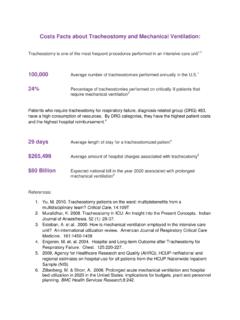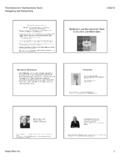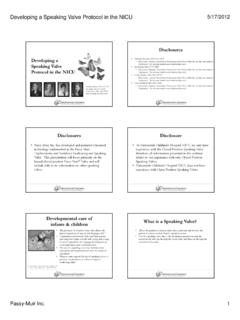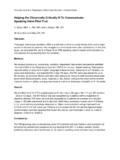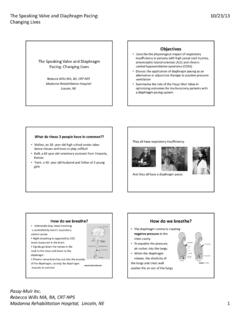Transcription of Passy Muir Valve Readiness Assessment and Use
1 Speech and Language PathologyPassy muir Valve Readiness Assessment and UsePurpose: To establish a standard protocol for referral for evaluation of Passy muir Valve Readiness and : This protocol specifically states - Passy muir Valve (PMV) - which is the most widely used speaking Valve , however, should an equivalent or more appropriate Valve be used for a specific patient, this protocol will represent the use of that Valve as Objective: A. The Passy muir Speaking Valve (PMV) may be used with patients with tracheostomy tubes with or without ventilator support.
2 Benefits of the PMV include, but are not limited to: 1. restoration of physiological PEEP 2. restoration of voice 3. improved sense of smell and taste 4. improved swallowing 5. improved secretion management 6. improved overall development and quality of life B. Contraindications for PMV Assessment : 1. severe airway obstruction 2. vocal cord paralysis - adducted position 3. severe neurological devastation 4. inflated tracheostomy tube cuff of any kind 5. foam-filled cuff 6. severe risk for aspiration C.
3 Candidates for referral must meet the following criteria: 1. post-operative tracheotomy 7 days or greater 2. medically stable 3. awake and responsive 4. patent upper airway 5. reasonably able to manage oral secretions 6. able to tolerate cuff deflation 7. trach collar or the following ventilator settings: FiO2 <60% PEEP <12II. Procedure: Assessment A. Physician consults Speech Language Pathologist (SLP) and ENT-APN for PMV Assessment B. Respiratory Therapy (RT), SLP and ENT-APN complete joint Assessment C.
4 RT will take responsibility for respiratory equipment operations/changes related to respiratory needs, any necessary ventilator adjustments and cuff deflation. D. Patient will be positioned in developmentally appropriate position. Patient most often positioned in supine for Assessment . Once trials are initiated placement may be altered to semi-reclined or upright depending on tolerance. E. Patient will be suctioned per unit policy F. ENT-APN completes Assessment using manometry to determine if transtracheal pressures are less than 20 cmH2O 1.
5 Manometry results >20 cmH20 require consideration of tracheostomy downsizing to be able to tolerate PMV 2. Cuff must be COMPLETELY deflated for Assessment and prior to PMV placement1234 Speech and Language PathologyIII. Application: A. If determined to be a candidate, SLP or ENT-APN place PMV for a trial period to assess tolerance and monitor vital signs (WOB, RR, HR, color, O2 saturations). B. Model of PMV selected will depend on use of ventilator or mist collar C. Placement of Valve will be dependent on Passy muir Valve type used: a) PMV 007: place PMV with adaptor inline between trach tube and omniflex or between omniflex and ventilator circuit b) PMV 2000 or PMV 2001: place directly on the tracheostomy tube hub D.
6 Set ventilator and monitor alarms per unit policy E. SLP assesses patient s vocal ability and management of secretions with PMV in place. F. Upon successful completion of PMV trial, PMV will be labeled with patient identification sticker and date opened clearly marked on the storage container. PMV will be kept by SLP until trials are completed. G. If any respiratory support changes were made for PMV application these changes should be reversed upon removal of the PMV H. If patient does not tolerate application of PMV, stop trials at that time and discuss with medical team to determine if changes could be made to ventilator settings to increase toleranceIV.
7 Documentation/Communication following the Assessment : A. ENT-APN and SLP will complete documentation of the Assessment in the patient s electronic medical record. B. SLP will place appropriate information/signs in patient s room/chart to inform staff that a PMV is used by this patient. C. RT will attach cuff deflation Warning Tag on trach cuff pilot if patient has a cuffed trach tube D. SLP will place an order in the patient s electronic chart placing the patient on the Speech Therapy treatment list for PMV trials and/or speech/language therapy.
8 Physician will then sign electronic order in patient s chart. PMV Trials/Wear Time Progression A. Initial PMV trials will be done by SLP only. Trials will be done 4-5 times within a 7 day period to closely monitor tolerance of PMV, vital signs and increase length of trial time. a) definition of a successful trial will be individually determined by the evaluation team taking into consideration the child s baseline B. PMV trial times will be documented within the patient s medical record and verbally communicated with the family and staff.
9 C. SLP and/or RT will educate medical staff and family regarding use of PMV. D. Only Caregivers/Family members who have been educated and have demonstrated knowledge of the PMV can place the PMV on the patient during visitation. E. Following successful SLP trials, placement of the Valve can be completed by the SLP, caregivers or nurse with an emphasis on increasing wear time and using the Valve in various contexts (therapies, feeding, cares, etc). F. NNP will place order in patient s electronic medical chart for daily PMV trials.
10 G. Therapists, nurses, and caregivers should provide close supervision during PMV use by monitoring alarms and vitals (WOB, RR, HR, color, O2 saturations)1234 Speech and Language PathologyV. Special Considerations: A. Do not use the PMV when patient is sleeping B. Do not use in combination with HME (heat/moisture exchanger) C. Take Valve off before aerosol/nebulized medication is administered D. Cleaning of the PMV: 1. The Valve should be cleaned daily by nursing with a mild soap and tepid water and air dry.
